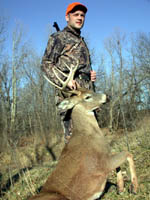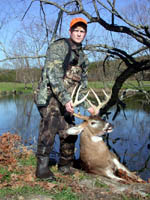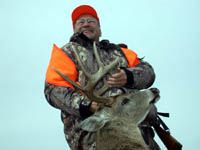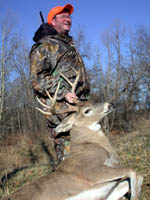
|
Features
|
|
|
|
Books
|
|
|
|
Fun & Games
|
|
|
|
Contact Us
|
|
|
John's Journal... Entry 222, Day 2
FIVE MOST CRITICAL INGREDIENTS FOR BAGGING A BUCK WITH A GUN
Bob Walker on Weather
 Editor's
Note: The five most-critical ingredients for taking a buck with your gun
at any time during the season include the wind, the weather, hunting pressure,
food availability and the rut. Most hunters will tell you one of these
factors has more importance to successful deer hunting than any other
element. However, you'll need to consider all these ingredients to develop
a successful hunt plan. This week we'll talk with some of the nation's
best gun hunters about their ideas. Bob Walker of Livingston, Alabama,
a guide at Bent Creek Lodge near Jachin, Alabama, and owner of R &
J Smokehouse, has lived in this deer-rich region of the country all his
life. For almost three decades, he consistently has taken an average of
five bucks per season with his gun.
Editor's
Note: The five most-critical ingredients for taking a buck with your gun
at any time during the season include the wind, the weather, hunting pressure,
food availability and the rut. Most hunters will tell you one of these
factors has more importance to successful deer hunting than any other
element. However, you'll need to consider all these ingredients to develop
a successful hunt plan. This week we'll talk with some of the nation's
best gun hunters about their ideas. Bob Walker of Livingston, Alabama,
a guide at Bent Creek Lodge near Jachin, Alabama, and owner of R &
J Smokehouse, has lived in this deer-rich region of the country all his
life. For almost three decades, he consistently has taken an average of
five bucks per season with his gun.
 You'll
find the best times to hunt deer during, just before and just after a
rain. When a cold front starts to move and rain begins to fall, bucks
start coming out of thick cover and moving into open woods where you can
see them better. The leading edge of a cold front often provides the best
day of the year to hunt a big buck. I study the radar weather map on TV's
"Weather Channel." I watch as a front moves across the country
and try to determine when the front will arrive in my area. Then I go
to the woods about two to three hours ahead of its arrival. During this
time, I'll generally see the most deer movement and usually take my biggest
buck. I've found the worst time to hunt, especially in my section of the
South, is when our area has extremely cold weather. When temperatures
drop in the teens, the cold weather will arrive with a really hard blowing
wind, either from the northwest or from the north.
You'll
find the best times to hunt deer during, just before and just after a
rain. When a cold front starts to move and rain begins to fall, bucks
start coming out of thick cover and moving into open woods where you can
see them better. The leading edge of a cold front often provides the best
day of the year to hunt a big buck. I study the radar weather map on TV's
"Weather Channel." I watch as a front moves across the country
and try to determine when the front will arrive in my area. Then I go
to the woods about two to three hours ahead of its arrival. During this
time, I'll generally see the most deer movement and usually take my biggest
buck. I've found the worst time to hunt, especially in my section of the
South, is when our area has extremely cold weather. When temperatures
drop in the teens, the cold weather will arrive with a really hard blowing
wind, either from the northwest or from the north.
 I
believe the wind more than the cold causes deer not to move. When a hard
wind blows, a deer loses its ability to see and hear movement in the woods.
A deer then has only one defense mechanism -- its nose -- to warn it of
danger. I've found, however, that deer often move in the middle of the
day on extremely cold days, probably because the wind doesn't blow as
hard then as at other times. Another time you'll see peak deer movement
is just as a rain storm moves out of your area. Go to the woods two hours
before you anticipate the rain will stop. The deer that have bedded down
during a heavy rain often will get up out of their bedding areas and move
toward feeding regions or breeding sites during the rut. If you hunt the
pre-rut when deer actively work scrapes, go to a scrape line during the
rain. Usually within one to two hours after the rain stops, you'll see
a buck coming along the scrape line to freshen-up his scrape because the
water washes away all signposting messages deer have left at a scrape.
I
believe the wind more than the cold causes deer not to move. When a hard
wind blows, a deer loses its ability to see and hear movement in the woods.
A deer then has only one defense mechanism -- its nose -- to warn it of
danger. I've found, however, that deer often move in the middle of the
day on extremely cold days, probably because the wind doesn't blow as
hard then as at other times. Another time you'll see peak deer movement
is just as a rain storm moves out of your area. Go to the woods two hours
before you anticipate the rain will stop. The deer that have bedded down
during a heavy rain often will get up out of their bedding areas and move
toward feeding regions or breeding sites during the rut. If you hunt the
pre-rut when deer actively work scrapes, go to a scrape line during the
rain. Usually within one to two hours after the rain stops, you'll see
a buck coming along the scrape line to freshen-up his scrape because the
water washes away all signposting messages deer have left at a scrape.
 Also
during a rain storm, I often will see deer in open fields and pastures
where I never may have seen them before. In the woods, bucks can't see
and hear movement well. However, in an open field or in a young clear-cut,
they can see danger coming from a great distance and feel more secure.
Deer have learned they rarely if ever will encounter hunters in the woods
during a rainstorm. Since most hunters don't like to hunt in the rain,
hunters will exert the least amount of pressure on an area during a rainstorm.
I believe deer take advantage of the decreased hunting pressure and tend
to move just as the rain starts or right after it ends.
Also
during a rain storm, I often will see deer in open fields and pastures
where I never may have seen them before. In the woods, bucks can't see
and hear movement well. However, in an open field or in a young clear-cut,
they can see danger coming from a great distance and feel more secure.
Deer have learned they rarely if ever will encounter hunters in the woods
during a rainstorm. Since most hunters don't like to hunt in the rain,
hunters will exert the least amount of pressure on an area during a rainstorm.
I believe deer take advantage of the decreased hunting pressure and tend
to move just as the rain starts or right after it ends.
To learn more, go to www.rjsmokehouse.com.
TOMORROW: DAVID HALE -- HUNTING PRESSURE
Check back each day this week for more about FIVE MOST CRITICAL INGREDIENTS FOR BAGGING A BUCK WITH A GUN...
Day 1 - Notice The Wind
With Dick Kirby
Day 2 - Bob Walker On Weather
Day 3 - David Hale -- Hunting Pressure
Day 4 - Dr. Keith Causey -- Food
Day 5 - Ronnie Groom -- The Rut